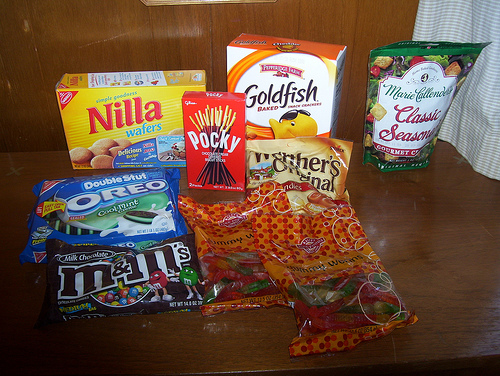

FOR IMMEDIATE RELEASE
Photo Credit: Jeff Cronin
These drinks, all with illegal claims on the labels, were found in the FDA cafeteria.
July 7, 2010
Food Frauds on Sale at FDA Headquarters!
CSPI Says Federal Labeling Cops Should Raid Their Own Cafeteria
WASHINGTON - July 7 - On a recent visit to the sprawling new Food and Drug Administration headquarters in the White Oak area of Silver Spring, Md., a lawyer from the nonprofit Center for Science in the Public Interest stopped for a quick, healthy lunch. Hiding in plain sight in the FDA cafeteria—quite literally under the noses of the officials tasked with policing misleading labels—were at least three beverages with illegal claims on their labels. The contraband drinks included:
* Purity.Organic Functional Drinks Pomegranate Blueberry. Its label claims it has “Ginkgo Biloba to enhance your memory and keep you thinking straight,” but government-funded studies show ginkgo has no effect on memory and does not lower incidence of Alzheimer’s or dementia, either. Ginkgo may have been “grown by monks for millennia” as the web site claims, but it isn’t Generally Recognized as Safe (or GRAS) as a food additive, according to FDA. (Plus, this product has more added sugar than it has pomegranate or blueberry juice.)
* Crystal Light Immunity Berry Pomegranate. This bright purple beverage’s label pictures blueberries and a pomegranate, yet the drink has no juice of any kind. Natural flavoring accounts for less than 2 percent of the product, and only an unknown fraction of that comes from the named fruits. The color comes from Red 40 and Blue 1 and the artificial sweetness comes from sucralose and acesulfame potassium. Vitamins A, B, C and E are listed on the ingredients list, but there is no evidence to support the implication that this drink will ward off colds or diseases, which is what is implied by the use of the word “immunity.” CSPI urged the FDA to take enforcement action against this product in 2008. (Plus, the bottle CSPI found in the FDA cafeteria was long past its “Best before 26 December 2007” expiration date.)
* SoBe Lifewater B-Energy Black Cherry Dragonfruit. Again, this drink has no black cherry or dragonfruit juice, but it does have guarana and ginseng (neither considered GRAS by FDA although the food industry considers them safe) and added vitamins. Using the word “energy” in the name and claiming that its B vitamins “help your body unlock the energy in foods,” implies that the drink will make one feel more energetic. But while B vitamins do help to convert protein, fat, and carbohydrates into energy, they don’t provide an energy boost that can be felt by the body. The “all natural” claim is unjustified because Lifewater contains added citric acid. And those without magnifying glasses might miss the fact that the bottle (described improbably as 2.5 servings) will supply 62.5 milligrams of caffeine, more than what you’d find in a 12-ounce can of Coke.
“To be fair, the FDA under the Obama Administration has done more to crack down on deceptive food labeling in the last 12 months than the Bush FDA did in eight years,” said CSPI legal affairs director Bruce Silverglade. “But the fact that we were able to find so many labeling problems in the FDA’s own cafeteria neatly illustrates why the agency needs to issue industry-wide rules, not just send warning letters to individual companies.”
Last December, CSPI sent the FDA a 158-page report documenting more than 50 false or misleading claims, ingredient obfuscations, and other labeling shenanigans that it found in supermarkets. CSPI recommended that FDA establish a systematic regulatory framework to prohibit misleading health-related claims, and require that nutrition information be based on realistic serving sizes—something that the drinks CSPI found in the FDA cafeteria fail to do.
“Consumers who want to ensure that they’re getting enough vitamins and minerals should focus on eating a wide variety of fruits and vegetables first,” Silverglade said. “No one should believe that the added vitamins, herbs or other ingredients in these flavored waters are going to ward off disease, improve memory, or make one more energetic. The FDA should frog-march these products into the food label penitentiary.”
###
Since 1971, the Center for Science in the Public Interest has been a strong advocate for nutrition and health, food safety, alcohol policy, and sound science.
CONTACT: CSPI
Phone: 202-332-9110

